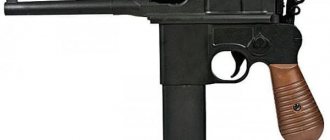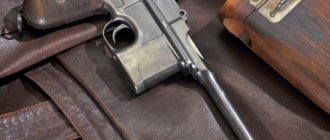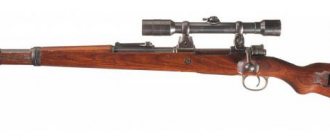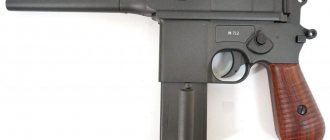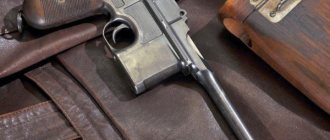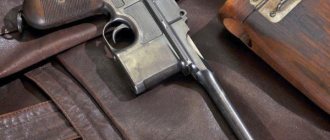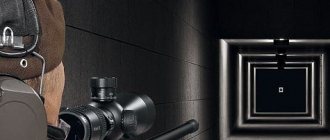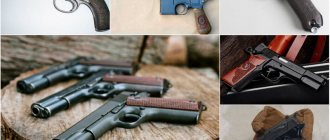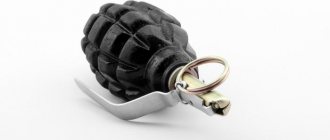Mauser K-96 carbine
In order to increase the range of weapons produced and attract the attention of potential customers, Waffenfabrik Mauser developed a pistol-carbine based on the Mauser K-96 pistol.
The weapon was supposed to be of interest to the military for use as a light cavalry carbine, and the Mauser K-96 carbine could be in demand among hunters and travelers. The first carbine was released in 1897. The pistol-carbine had a 300 mm long barrel, a full stock and a fore-end located under the barrel. The first models of pistol-carbine were produced with a so-called cone trigger.
Later they began producing carbines with a trigger in the form of a large ring. The carbine frame, unlike the standard Mauser K-96 pistol, was distinguished by the absence of a handle frame. Instead, guide grooves were made in the lower part of the weapon frame into which the butt was installed.
The butt was fixed using a special button located on the left side of the butt body. The lid of the magazine box protruded slightly forward and slightly covered the forend from the bottom. The carbines were manufactured chambered for the 7.63×25 Mauser cartridge.
The carbine's chamber had an octagonal cross-section and smoothly transitioned into a round barrel. The top of the chamber bore the markings of the Mauser factory in Oberndorf. Carbines made on the basis of the Mauser K-96 pistol have a locking of the trigger mechanism when the butt is disconnected. A weapon without a stock or pistol grip attached cannot fire. This design feature was due to the requirement of German law for folding long-barreled weapons.
Otherwise, the design of the carbine was practically no different from the Mauser K-96 pistols, which had a frame with a milled outer surface. A little more than 800 copies of carbines of this design were produced. Their production ended by 1905.
It is interesting that, unlike many Mauser K-96 pistols, the maximum distance scale of not 1000, but only 500 meters was marked on the aiming bar of the carbine.
Some carbines were additionally equipped with detachable pistol grips. For such a weapon, the butt was easily replaced with a handle and the weapon turned into an elongated pistol.
The front sight on carbines was more massive than on short-barreled weapons; it was often of a closed type.
At the initial stage of production, the Mauser K-96 carbine pistol was produced with a barrel length of 300 mm; by the end of carbine production, the barrel length was increased to 370 mm.
After a short break, around 1907 the production of Mauser C96 carbine pistols with triggers in the form of a small ring and a smooth frame that did not have the milled recesses characteristic of Mausers on the outer surfaces was resumed.
The weapon was also equipped with a new model fuse.
However, the carbine remained unclaimed by both the military and the civilian market, and due to low demand, after the release of the last batch of approximately 140 copies, the production of carbines was finally stopped.
The total number of carbines produced is, according to some estimates, about 1,100 pieces. For an original weapon this is a very small figure. That is why the demand among collectors for these weapons is very high. The average price for a Mauser K-96 carbine ranges from 12 to 18 thousand dollars. There is a known case when, at one of the auctions, a Mauser K-96 carbine in excellent condition was sold for $34,500.
Currently, a few modern modifications of carbines with barrels 400 mm or more in length are produced. Hunters, collectors and gun enthusiasts, especially in the USA, are happy to purchase these weapons.
The last real Mauser
Bolt-action rifles are traditionally considered more accurate and are used for hunting where a “long” shot is needed.
PHOTO SHUTTERSTOCK But today we will not talk about him, but about the Mauser 66 rifle (Mauser mod. 66S).
I’ll say right away: it’s almost as beautiful as the Mauser 98, but it’s almost unknown among us.
And it's very strange.
How so?
A reliable, simple and brutal rifle, at the same time quite inexpensive and - unknown?
And the secret is that they stopped producing it long before they began importing and selling imported weapons into Russia.
So it turned out that we couldn’t get new rifles, and secondary rifles were only delivered to order, and in order to order the Mauser 66S, you had to know about it.
Such a vicious circle led to the fact that few people in Russia had heard of the famous rifle, and, accordingly, even fewer people had it.
Today everything has changed. New imported weapons are practically not supplied, but weapons from the secondary market in Europe are available. It was there that the 66th was quite popular and that is why it began to appear on our market.
I must say, this carbine is truly amazing. It shows the features of the good old Mauser (for example, a bolt with rotation and locking on two powerful lugs), and features of future (for that time) modular rifles.
Having looked at the Mauser 66, you will no longer perceive the Blazer P96 as innovative. The mechanisms for attaching the barrel to the stock are very similar. True, in the Mauser there are concerns that attaching the barrel with two bolts directly to the stock is not very reliable, so the rifle has a powerful steel skeleton, but the rest is very similar.
It is also clear that in 1966 they had not yet decided to completely abandon the steel part of the box; it is movable and moves along grooves in the steel base, while in the Blazer everything is much simpler and looks more fragile.
But let's get to know our hero better. As I wrote above, this is a classic rifle with a longitudinally sliding bolt and locking by turning this bolt onto two lugs. But that's where its similarities to the Mauser 98 end.
The designer abandoned the box altogether. The bolt is locked directly onto the barrel. This made it possible to shorten the box (and therefore the bolt body) by almost half. But how is this possible, you ask. After all, since the cartridge remains the same, then the stroke of the bolt itself should not change.
It’s very simple: the design provides for the movement of the shutter half its length, and then the movement occurs due to the rollback of the upper part of the box. An original and non-standard solution that made it possible to make the rifle shorter.
| Photo by the author. |
The second original solution is to move the magazine and place it above the trigger guard. Let me remind you that in a classic rifle it is located in front of the trigger guard. This forced the entire USM to change, but also saved space.
On the plus side, the magazine is simple and reliable, it is double-rowed, does not protrude beyond the dimensions of the weapon at all, it is simply not visible. The downside is that it only holds three or four rounds, depending on the caliber, and it is impossible to increase its capacity. It also cannot be discharged through the bottom, but this was already difficult for a Mauser rifle.
To remove the bolt, you need to turn it and pull it back until it stops, then press the small steel key located on the right and remove the bolt and the upper part of the box moving backwards.
It is the upper part of the box that is responsible for the forward and backward movement; it is massive, steel, and entirely milled. Its movements are smooth and have no backlash. This brings to mind the classic Mauser bolt. Whatever its fit in the rearmost position, it still has play and can jam due to misalignment.
There is nothing even remotely similar here. Everything moves as if on rails, but the bolt is located, as it were, inside a steel box: on top is the moving part of the bolt box, on the bottom is a massive steel base.
The shutter itself looks unusual: it is short; The reloading handle is moved forward and bent strongly down and back. Despite the fact that the bolt is on two lugs and to unlock it you need to turn it almost 900, it is convenient to do this without lifting the butt from your shoulder. The bolt cup is closed, and, as a result, the cartridge feed is uncontrolled. This is an interesting feature.
The fact is that the Mauser 98 from the very beginning and still insists on a controlled feed of the cartridge, with it, as soon as the cartridge rises to the feed line from the magazine, the ejector enters the groove of the cartridge case.
The cartridge cannot go anywhere, and if necessary, you can pull the bolt back without locking the barrel and throw out the cartridge. When fed uncontrolled, the cartridge receives a blow from the bolt and, leaving the magazine, flies freely into the chamber.
The ejector engages the groove only when the chamber is locked with the bolt. The debate about which is better has been going on for a hundred years, and Mauser has always been the adept of controlled feed, and American designers have always been an adept of uncontrolled feed. Something went wrong in '66...
As a result, we have a completely closed bolt at the front, a spring-loaded ejector and a spring-loaded cartridge deflector - all as they like in the USA.
| When you change the barrel, the bolt of the rifle also changes. Photo by the author. |
The safety, a double-sided push-button, is located on the rear of the bolt. When it is turned on, the firing pin and the bolt are blocked, which cannot be opened when the safety is on. The 66th model has a very powerful steel base, to which all elements of the weapon are attached and on which the moving part of the box moves.
It is clear that the design team is still afraid to weaken and lighten the structure; everything is done with a reserve, I would even say, with a triple reserve. "Mauser 66" was created for almost all powerful calibers. This is both .375NN and 9.3x64.
By the way, the sample in the photo is equipped with two barrels .30-06 and 9.3x64, which is most interesting for us, since both of these cartridges are produced in Russia.
The trunks are massive, heavy, forged. The rifle has earned a reputation as an accurate and reliable weapon. The trigger usually has a trigger, but the rifle we photographed has only one trigger. Which is better is absolutely a matter of taste.
For accurate shooting, of course, the sneller is convenient, but many hunters do not like it because of the possibility of confusing the “triggers” at a critical moment.
Such cases are described in the literature: in a critical situation, the hunter presses the trigger, thinking that this is a descent, but there is no shot; Believing that he forgot to chamber the cartridge, the shooter jerks the bolt and sees the “unfired” cartridge flying out.
But this happens when the weapon is foreign or new. Most hunters quickly get used to the sneller and use it when it is convenient and necessary. For those who don't like it, there is an option with one release.
The barrel can be removed quickly and easily: two screws are unscrewed and that’s it. When replacing with another caliber, which also differs in the size of the case bottom, the bolt also changes. The sight is mounted on quick-release brackets, the mounting points are located on the barrel.
This is understandable, since the rifle does not have a box as such. It turns out that you can attach a sight to each barrel and not remove it when changing the barrel.
The following caliber options were available: standard 5.6x57 mm, .243 Winchester, 6.5x57 mm, .270 Winchester, 7x64 mm Brenneke, .30/06, .308 Winchester, 9.3x62 mm; The barrel length for these calibers was 60 cm; rifle "magnum": 6.5x68 mm, 7 mm Remington Magnum, 8x68S, .300 Winchester Magnum, 9.3x64 mm Brenneke; The barrel length for these calibers was 65 cm; African for hunting the big five: .375 Holland & Holland Magnum, .458 Winchester Magnum; The barrel length for these large calibers was 65 cm.
As we can see, the choice is very good; it is quite possible to choose an option that will also use Russian-made cartridges.
| PHOTO SHUTTERSTOCK |
It should be noted that not all calibers could be combined in one rifle, and here’s why. The Mauser 66's interchangeable barrel system allows the owner to have two calibers available in one rifle.
But the peculiarity was and is that the calibers to be replaced must correspond to the dimensions of the bolt body. For the Mauser 66, there are four groups of calibers within which barrel replacement is possible.
Group 1. The diameter of the shutter body is 12.2 mm. These calibers are: 5.6x57 mm, .243 Winchester, 6.5x57 mm, .270 Winchester, 7x64 mm Brenneke, .308 Winchester, .30/06, 9.3x62 mm. Group 2. The diameter of the shutter body is 12.65 mm. This is a 9.3x64mm Brenneke caliber. Group 3. The diameter of the shutter body is 13.1 mm. These are calibers: 6.5x68mm, 8x68cm. Group 4. The diameter of the bolt body is 13.58 mm. These calibers are: 7 mm Remington Magnum, .300 Winchester Magnum, .375 Holland & Holland Magnum, .458 Winchester Magnum.
Note: The factory manual for the Mauser 66 does not list the .300 Weatherby Magnum as an available caliber, but does list the available interchangeable barrels.
So it would be possible to have a Mauser 66 that was 7x64mm and .30/06 as well as 9.3x62mm since they all have the same bolt body dimensions.
Or you could have one with 6.5x68mm and 8x68mm barrels, or one with a bolt action for belted magnums, and then you could use calibers like the 7mm Remington Magnum and any other belted magnums. However, there are few multi-barrel rifles on the aftermarket.
| PHOTO SHUTTERSTOCK |
Apparently, in the 70s, hunters had not yet tried rifles with interchangeable barrels. There was a lot of debate back then: does it make sense to have one rifle with interchangeable barrels, each equipped with a scope, or is it better to buy several rifles?
In our country, this was subject to a restriction of five rifled barrels, which tipped the scales heavily towards “multi-barreled” rifles, allowing for multiple calibers in a single resolution.
Separately, I would like to describe the feeling of working with this rifle. First of all, the 66th model perfectly conveys the era of the 60-70s of the last century - a time when design thought and design went hand in hand and a new visual range was created not only in houses, furniture and cars, but also in weapons.
The rifle is distinguished by its individuality and brutality. The feeling it gives is unusual and unique. So, when closing the bolt, it is like closing an old gun safe with a rotary locking mechanism: first the massive steel door closes tightly, and then a powerful, oiled lever lock enters and turns.
Everything is solid and reliable, without any feeling of heaviness or tension. In general, a very pleasant feeling.
But an inquisitive reader, of course, will say: yes, the Mauser is interesting, but why the last one? This is, of course, hyperbole.
It’s just that this is one of the last rifles made entirely of steel and walnut and in the ancestral nest of all Mausers - in the city of Oberndorf am Neckar.
Alexander Mishin October 12, 2022 at 02:10 pm
